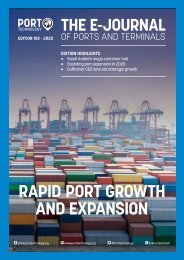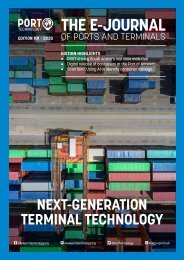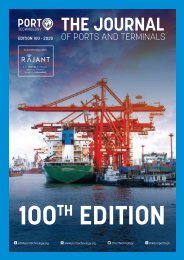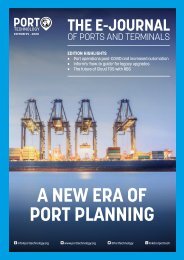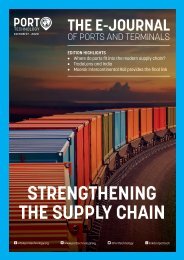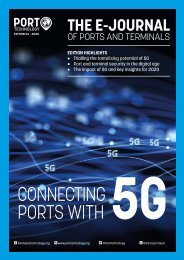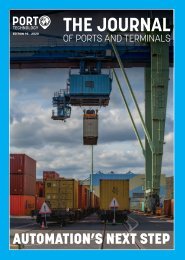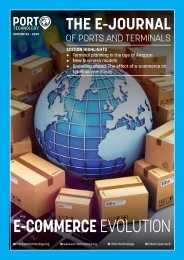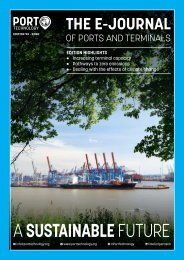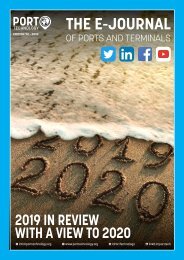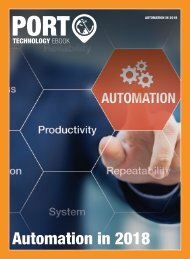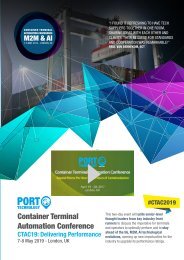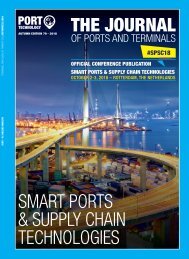Automation Innovations
As we enter the second half of 2020 the full effects of the COVID-19 pandemic are now being realised across the global economy and the port industry. For many, cargo throughput has been significantly decreasing compared with the same period for 2019. For example, the Port of Los Angeles handled 581,665 TEUs in May, a 29.8
As we enter the second half of 2020 the full effects of the COVID-19 pandemic are now being realised across the global economy and the port industry. For many, cargo throughput has been significantly decreasing compared with the same period for 2019.
For example, the Port of Los Angeles handled 581,665 TEUs in May, a 29.8
You also want an ePaper? Increase the reach of your titles
YUMPU automatically turns print PDFs into web optimized ePapers that Google loves.
AUTOMATION INNOVATION<br />
STAYING AHEAD OF THE GAME<br />
DIGITIZATION AT THE PORT OF TANJUNG PELEPAS<br />
Beth Maundrill, Editor, Port Technology International<br />
As Malaysia continues to develop itself as<br />
one of the most important hubs for global<br />
trade, the Port of Tanjung Pelepas (PTP) is<br />
playing a critical role in this ambition.<br />
Part of this transformation is going to be<br />
the integration of new and improved technologies,<br />
such as automation, new Terminal<br />
Operating Systems (TOS) and cloud-based<br />
technology.<br />
For PTP, to have an advance digital infrastructure<br />
is key in ensuring that the port remains<br />
ahead of its competitors. Currently,<br />
PTP is the third biggest port in Southeast<br />
Asia and one of the 20 largest in the world,<br />
with approximate terminal capacity of 12.5<br />
million TEU.<br />
GOING LIVE<br />
PTP spoke to Port Technology International<br />
in a recent interview about its<br />
pursuit of greater terminal efficiency and<br />
its aim to remain competitive in this fastpaced<br />
landscape. Equipment automation<br />
and digitization have become key focus<br />
areas to ensure the port is are able to<br />
stay ahead.<br />
For instance, the Opsview Real Time<br />
Performance Monitoring System has been<br />
integrated at PTP with the aim to improve<br />
efficiency, increase berth productivity and<br />
reduce operating costs. The system gives<br />
PTP the visibility of its live operation performance<br />
and all of its assets. The cloud-based<br />
system can be viewed from any device and<br />
gives a clear understanding towards the<br />
utilisation of assets whilst minimising waste<br />
and turnaround times of assets.<br />
With regards to digital processes, PTP<br />
successfully migrated its TOS to Navis N4<br />
in 2019, representing one of the largest<br />
such terminal system migration projects yet<br />
undertaken at the port. This TOS provides<br />
improved performance and scalability to<br />
meet the future expected volume growth<br />
of PTP. With Navis N4 in operation, a world<br />
record for vessel utilisation was successfully<br />
recorded after MSC Gulsun, the largest<br />
container ship in the world at the time, departed<br />
with 19,574 TEU in July 2019.<br />
PTP also recently went live with its 1st<br />
Phase intelligent Enterprise Resource Planning<br />
system (ERP) to transform and streamline<br />
the company’s core back-end operations<br />
such as finance, human resources and<br />
procurement. With the new ERP system,<br />
PTP employees will be able to upscale requisite<br />
digital skills and online presence in<br />
order to be more efficient while ensuring<br />
best practice and service to the customers.<br />
ALL PORTS ON PATHS TO DIGITIZATION<br />
There are numerous ports in the Southeast<br />
Asia region that are on a pathway towards<br />
more automation and digitization. However,<br />
collaboration in the transhipment market<br />
is particularly limited because of the<br />
competitive nature of the environment.<br />
PTP notes that every terminal is trying<br />
to develop technologies and or use current<br />
technology in a different way to get a commercial<br />
advantage and therefore retain and<br />
or gain market share via improved productivity<br />
and or customer connectivity.<br />
However, there are some collaboration<br />
possibilities for the Port as two of its shareholders<br />
include MMC and APM Terminals.<br />
This enables various digitization and automation<br />
collaboration initiatives to proceed<br />
18 EDITION 98<br />
WWW.PORTTECHNOLOGY.ORG




